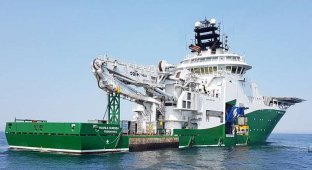This question will be answered by Kirill Plotnikov, an engineer, senior lecturer at the Department of Design and Technical Operation of Ships, Faculty of Shipbuilding and Ocean Engineering, St. Petersburg State Medical University.

The attitude of sailors towards the anchor in the era of the sailing fleet is reflected in the expressions of the French language that have reached us: “ancre d'esperance” - anchor of hope, “ancre sacree” - sacred anchor and even “maitresse ancre” - lady anchor (in French the word “anchor” " female). Anchors (and there were usually several of them on a ship) were used not only to hold the ship in a given place in the water area, but also to slow down and even move the ship. Today this device is still indispensable.
The holding force of a ship's anchor device consists of two components: the first is created by the anchor when interacting with the sea soil, the second is created by the section of the anchor chain that lies on the ground (for sea vessels, the length of this section is usually at least 25–50 m).
For reliable anchorage, the weight and design of the anchor are important. They usually weigh several tons, and on giant ships with large sails (aircraft carriers, ocean cruise ships, etc.), they use anchors weighing up to 30 tons. Impressive figures, but it should be understood that the total weight of the anchors is not makes up even a tenth of a percent of the weight of the ship itself.
Each specific type of anchor behaves differently on different types of soil. The holding force of an anchor is the force that must be applied to it in order to pull it out of the ground at the moment when the spindle (the massive rod to which the anchor horns are attached) is located horizontally. To compare different models, they usually say how many times the holding force of the anchor exceeds its own weight (the so-called “holding force coefficient”).

Names of anchor parts
The first device that ancient sailors used as an anchor was an ordinary stone tied with a rope made of animal veins, plant stems, and vines. The holding force coefficient of such an “anchor” is less than one, that is, its holding force is less than its weight.
Later, they began to drill holes in the anchor stones and install stakes (horns) in them. Already during the time of the ancient Romans, the anchor became similar to the one that can be seen today on caps and cockades. The horns were fixedly attached to the massive spindle at the bottom. With one of the horns the anchor entered and buried itself in the ground. Since such an anchor falls “flat” to the bottom (that is, the horns are located in the plane of the bottom, and without additional devices the anchor will not engage and will drag along the ground), another rod was put on the spindle perpendicular to the horns - the rod. When falling on the rod, the anchor, under the influence of the tension of the rope, turned on the ground and entered the ground with its horn. On the emblems that readers have seen many times, the rod is the transverse “stick” at the top of the anchor.

By 1852, the Admiralty anchor became the most popular. In subsequent years, thousands of applications were submitted to patent offices for the invention of new, more advanced anchors. Thus, the rod that prevented the anchor from being pulled into the niche on the side of the ship (called the “hawse”) was eliminated, and the “feet” became rotary. The most typical anchor of this type is named after its creator - the Hall anchor. It enters the ground with two “paws” at once. At the same time, its holding capacity is less than that of the Admiralty, but this, thanks to the ease of use, can be tolerated. New anchor designs continue to appear to this day.

Anchor Cemetery in Portugal
No matter how perfect the anchor devices are, they cannot provide anchorage in all conditions; much depends on the wind. In maritime practice, wind speed is assessed using a special 12-point scale called the Beaufort scale, where zero points corresponds to complete calm, and 12 points to a hurricane. For most vessels, anchoring is usually advisable in winds up to force 6–7. In addition, the speed of the current and the depth of the water area are taken into account.

Setting and unanchoring
Despite the current availability of more advanced ship holding systems (for example, dynamic positioning systems associated with satellite navigation), anchors will remain the simplest, cheapest and most reliable device for many decades to come, absorbing the romance of seamanship.
























